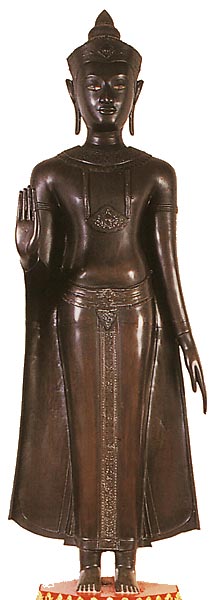Buddha Images in the Khmer or Lopburi style
Lopburi art goes back to the 11-13th century A.D. Lopburi was a provincial capital during the Khmer empire. At times it experiences periods of independence, but its art form and Buddha images display Khmer influence.
Buddha images often display a cranial protuberance in the form of three tiered lotus petals. A hair band is featured, and the hair of the Buddha can be straight like human hair. The head is often decorated with a diadem of face frame. Thick lips, a smiling face, prominent earlobes are featured.
A robe is draped diagonally with a straight edged mantle over the left shoulder, extending to the navel. Often the Buddha image is displayed on a lotus petal base. Seated Naga protected Buddha images in the meditation posture are common. Sometimes the Naga protected Buddha appears with Royal ornaments, and has a more stern facial expression.

With the gesture (see right hand) of preaching. Cast and enlarged from an old model.
Image present in the cloister of the Ubosoth at Wat Benchamabophit, Bangkok.

In the style of the Lopburi period.
Found in Phetchaburi province.
Image present in the cloister of the Ubosoth at Wat Benchamabophit, Bangkok.

Naga protected Buddha image. Notice the cranial protuberance in the form of three tiered lotus petals.

In the Khmer style.
Found at Wat Si Chin, Thonburi.
Image present in the cloister of the Ubosoth at Wat Benchamabophit, Bangkok.

In the style of the Lopburi period.
Cast and enlarged from an ancient model.
Image present in the cloister of the Ubosoth at Wat Benchamabophit, Bangkok.

In the style of the Lopburi period.
Cast and enlarged from an ancient model.
Image present in the cloister of the Ubosoth at Wat Benchamabophit, Bangkok.

In the style of the Lopburi period.
Cast and enlarged from an ancient model.
Image present in the cloister of the Ubosoth at Wat Benchamabophit, Bangkok.

In the style of the Lopburi period.
Cast and enlarged from an ancient model.
Image present in the cloister of the Ubosoth at Wat Benchamabophit, Bangkok.

In the style of the Lopburi period.
Cast and enlarged from an ancient model.
Image present in the cloister of the Ubosoth at Wat Benchamabophit, Bangkok.

In the Khmer style of the Lopburi period.
Cast and enlarged from an ancient model.
Image present in the cloister of the Ubosoth at Wat Benchamabophit, Bangkok.

Wearing the attributes of Royalty.
In the style of the Lopburi period.
From Wat Tewarat, Bangkok.
Image present in the courtyard behind the Ubosoth at Wat Benchamabophit, Bangkok.
![]() Characteristics and Postures of the Buddha
Characteristics and Postures of the Buddha
![]() Sitting Buddhas
Sitting Buddhas
![]() Reclining Buddhas
Reclining Buddhas
![]() Seven Days of the Buddha
Seven Days of the Buddha
Hand Gestures :
![]() The Six Main Mudras
The Six Main Mudras
![]() Dhyana Mudra
Dhyana Mudra
![]() Bhumisparsha Mudra
Bhumisparsha Mudra
![]() Abhaya Mudra
Abhaya Mudra
![]() Vitarka Mudra
Vitarka Mudra
![]() Varada Mudra
Varada Mudra
Historical Periods :
![]() Dvaravati
Dvaravati
![]() Khmer-Lopburi
Khmer-Lopburi
![]() Chiang Saen - Lanna
Chiang Saen - Lanna
![]() Sukhothai
Sukhothai
![]() U Thong
U Thong
![]() Ayutthaya
Ayutthaya
Historical Notes :
![]() Dvaravati
Dvaravati
![]() Sukhothai
Sukhothai
![]() Ayutthaya
Ayutthaya
![]() Resources
Resources
Temples in Thailand :
![]() Overview
Overview
![]() Wat Pho
Wat Pho
![]() Wat Benchamabophit
Wat Benchamabophit
Buddha Images at :
![]() Buddha Images at Wat Phra Pathom Chedi
Buddha Images at Wat Phra Pathom Chedi
![]() Introduction to Buddhism in Thailand
Introduction to Buddhism in Thailand
![]() The 10 Jatakas (lives of the Buddha) as depicted in Thai mural Temple paintings
The 10 Jatakas (lives of the Buddha) as depicted in Thai mural Temple paintings
More about Thailand at ThaiWebsites.com : Articles, and Web Directory
Content by Guido Vanhaleweyk, Bangkok.

.png)